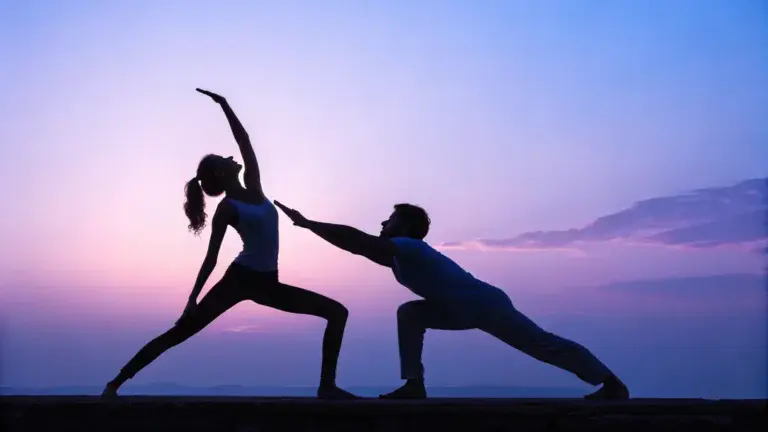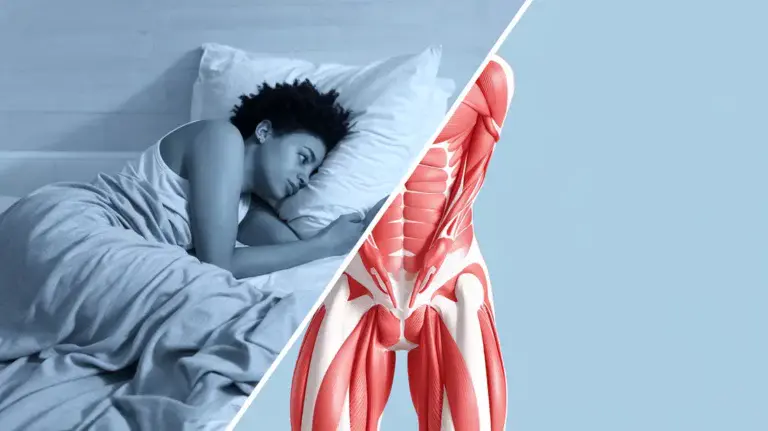Hip flexor stretches for runners are essential for maintaining optimal performance and preventing injuries.
Have you ever felt that nagging tightness in the front of your hips during or after a run?
Or noticed your stride length shortening as you log more miles?
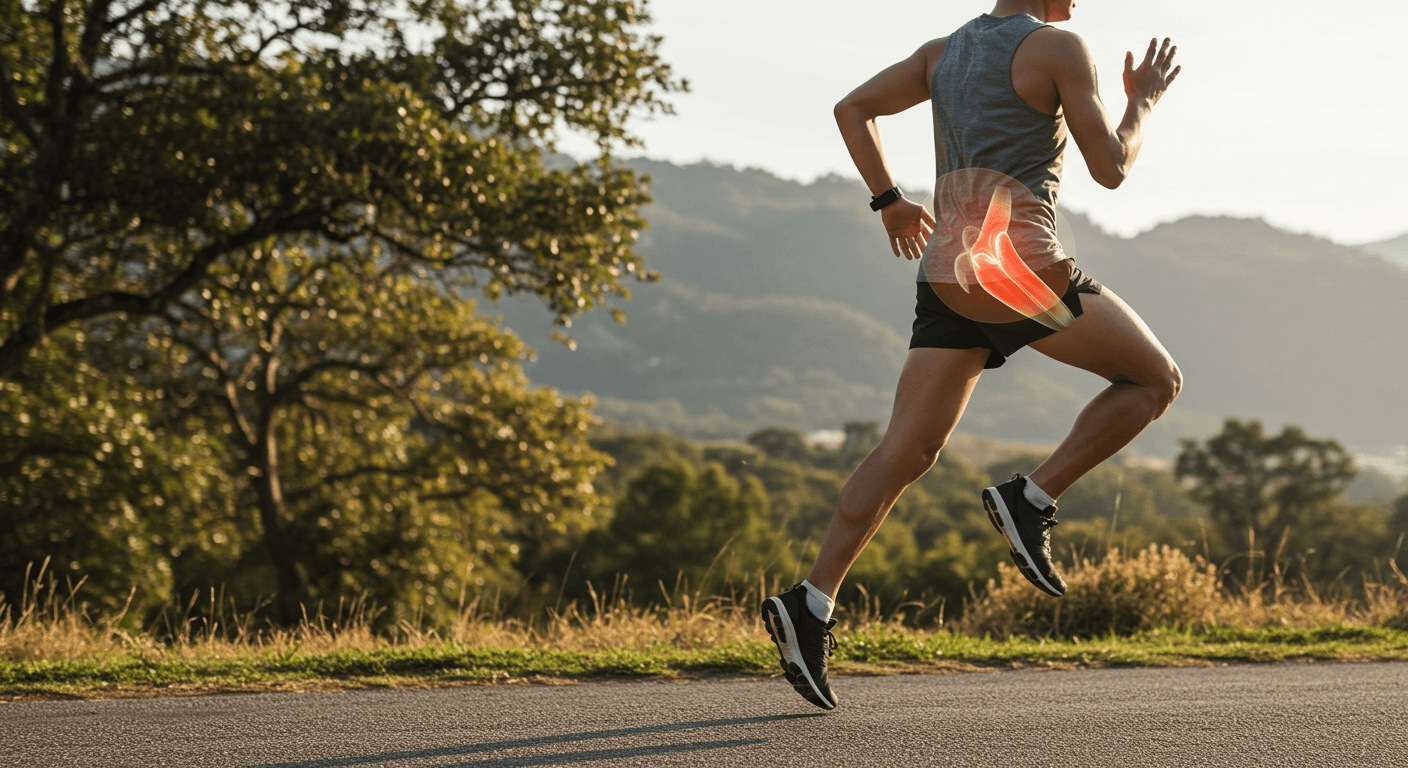
If so, your hip flexors might be crying out for attention.
As a runner, these crucial muscles can make the difference between efficient, injury-free running and a frustrating cycle of discomfort and compromised performance.
In this comprehensive guide, we’ll explore why your hip flexors matter, how they affect your running, and most importantly, the most effective stretches to keep them healthy and functioning optimally.
Whether you’re training for your first 5K or your tenth marathon, these strategies will help you run stronger, longer, and with better form.
Tight hip flexors are one of the most common issues I see in runners, yet they’re often overlooked until they cause significant problems with form or lead to injury. — Dr. Amanda Johnson, Sports Medicine Specialist at Runner’s Medical Center.
What Are Hip Flexors and Why Do They Matter for Runners?
Your hip flexors are a group of muscles located at the top of your thighs that play a critical role in movement.
These muscles work together to flex your hip joint, allowing you to lift your knees and bend at the waist.
The primary hip flexor muscles include:
- Iliopsoas: Comprised of the iliacus and psoas major muscles, this is the most powerful hip flexor
- Rectus femoris: Part of your quadriceps that crosses both the hip and knee joints
- Sartorius: The longest muscle in the body, running from the outside of the hip to the inside of the knee
- Pectineus: A flat, quadrangular muscle located in the inner thigh
- Tensor Fasciae Latae (TFL): Works with the iliopsoas to flex the hip
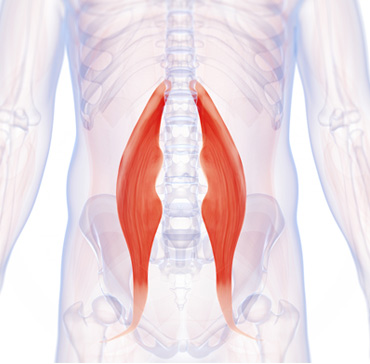
During running, your hip flexors engage with every stride.
They help lift your leg forward, contribute to proper knee drive, and maintain an efficient running form.
Well-functioning hip flexors allow for a full range of motion and optimal stride length, translating to better running economy and performance.
How Tight Hip Flexors Affect Running Performance and Increase Injury Risk
Many runners develop tight hip flexors due to the repetitive nature of running itself or from spending hours sitting at a desk.
When these muscles become tight, several issues can arise:
Inefficient Stride
Tight hip flexors restrict your range of motion, preventing your leg from extending fully behind you during the push-off phase of your stride.
This limitation forces you to take shorter steps, requiring more energy to cover the same distance.
It’s like trying to drive with the parking brake partially engaged—you’ll still move forward, but it’s far from efficient.
Increased Stress on Other Joints
When your hip flexors can’t do their job properly, your body compensates by recruiting other muscles and placing additional stress on surrounding joints. This compensation pattern often leads to:
- Knee pain
- Lower back discomfort
- IT band syndrome
- Hamstring strains
Poor Posture and Alignment
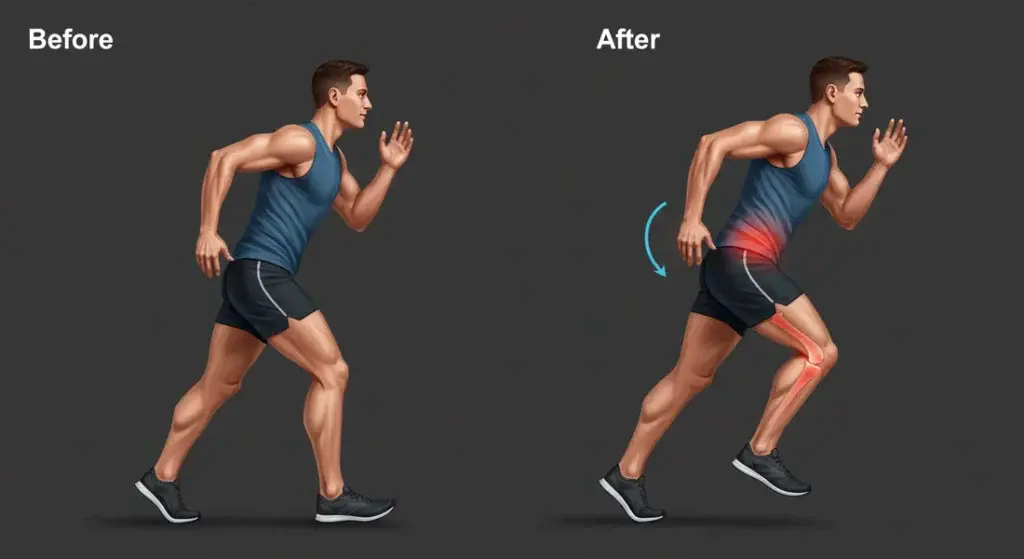
Tight hip flexors can pull your pelvis into an anterior tilt (forward rotation), creating an exaggerated arch in your lower back.
This misalignment affects your entire kinetic chain, from your feet to your head, compromising running form and efficiency.
Higher Risk of Strains and Tears
Like any tight muscle, restricted hip flexors are more vulnerable to strains or tears, especially during explosive movements like sprinting or hill running.
A sudden acceleration or change in terrain can be all it takes to trigger an injury in already compromised tissues.
Runner’s Story: For years, I struggled with recurring lower back pain after my long runs. No amount of rest or back stretches seemed to help. After working with a physical therapist who identified my tight hip flexors as the culprit, I began a consistent stretching routine. Within three weeks, my back pain disappeared completely, and I shaved 4 minutes off my half marathon time! — Maria T., marathoner and running coach
Effective Hip Flexor Stretches for Runners
Incorporating the following stretches into your routine can help maintain or restore hip flexor flexibility, improving your running performance and reducing injury risk.
For each stretch, aim to hold for 30 seconds and repeat 2-3 times on each side.
1. Kneeling Hip Flexor Stretch
This classic stretch effectively targets the iliopsoas muscle.
How to perform:
- Start in a half-kneeling position with your right knee on the ground and left foot planted in front
- Keeping your torso upright, gently push your hips forward until you feel a stretch in the front of your right hip
- For a deeper stretch, raise your right arm overhead and slightly lean to the left
- Hold, then switch sides
Pro tip: Place a cushion under your knee for comfort and maintain a slight posterior pelvic tilt (tucked tailbone) to maximize the stretch.
Before feeling: Tightness when lifting knees, reduced stride length
After consistent practice: Improved knee lift, longer stride, less strain during hill running
2. Standing Hip Flexor Stretch
Great for when you’re short on time or need a quick stretch at work.
How to perform:
- Stand tall with feet hip-width apart
- Take a step back with your right foot, keeping your heel raised
- Bend your left knee slightly while keeping your right leg straight
- Push your right hip forward while maintaining an upright torso
- Hold, then switch sides
Pro tip: Hold onto a wall or chair for balance if needed.
Before feeling: Difficulty standing after long periods of sitting
After consistent practice: Reduced stiffness when transitioning from sitting to standing or running
3. Active Hip Flexor Stretch
This dynamic stretch helps improve both flexibility and strength.
How to perform:
- Start in a lunge position with your right knee on the ground and left foot planted in front
- Place your hands on your left thigh for support
- Engage your right glute and push your hip forward
- Maintaining this position, lift your right knee slightly off the ground for 2 seconds
- Lower and repeat 10 times before switching sides
Pro tip: Focus on the mind-muscle connection, actively contracting your glutes while stretching.
Before feeling: Weakness in hip flexors during hill climbs
After consistent practice: Stronger hip drive on hills, improved power in sprint finishes
4. Supine Hip Flexor Stretch
This gentle stretch is perfect for those with sensitive lower backs.
How to perform:
- Lie on your back near the edge of a bed or bench
- Bring both knees toward your chest
- Hold your right knee close while allowing your left leg to hang off the edge
- Gently lower your left leg, feeling the stretch in the front of your hip
- Hold, then switch sides
Pro tip: Keep your lower back pressed into the surface to prevent arching.
Before feeling: Lower back pain after runs
After consistent practice: Reduced back tension, more comfortable recovery periods
5. Seated Hip Flexor Stretch
Ideal for office breaks or when traveling.
How to perform:
- Sit at the edge of a chair with feet flat on the floor
- Extend your right leg behind you, keeping the ball of your foot on the floor
- Keeping your spine straight, lean forward slightly from the hips
- Hold, then switch sides
Pro tip: Sit on a folded towel to elevate your hips if this is difficult.
Before feeling: Stiffness after long periods of sitting
After consistent practice: Easier transition from desk to running, less warm-up time needed
6. Prone Hip Flexor Stretch
A more advanced stretch that also engages your core.
How to perform:
- Lie face down on a mat
- Bend your right knee to a 90-degree angle
- Grab your right ankle with your right hand
- Gently pull your heel toward your glute
- Hold, then switch sides
Pro tip: Keep your core engaged to prevent lower back arching.
Before feeling: Limited hip extension, feeling of “pulling” during stride
After consistent practice: Smoother stride, especially during faster-paced running
7. Dynamic Lunges
These functional movements help improve mobility while mimicking the running motion.
How to perform:
- Stand tall with feet together
- Take a large step forward with your right foot
- Lower your body until both knees are bent at 90-degree angles
- Push off your right foot to return to standing
- Repeat with the left leg
- Continue alternating for 10-12 repetitions per side
Pro tip: Focus on proper alignment—knee tracking over toes and maintaining an upright torso.
Before feeling: Difficulty with explosive movements, slower acceleration
After consistent practice: Improved speed off the line, more powerful stride
Dr. Kristina DeMatas, physical therapist for elite distance runners, recommends, Consistency with these stretches is far more important than intensity. Five minutes daily will yield better results than an occasional 30-minute session.
Integrating Hip Flexor Stretches into Your Running Routine
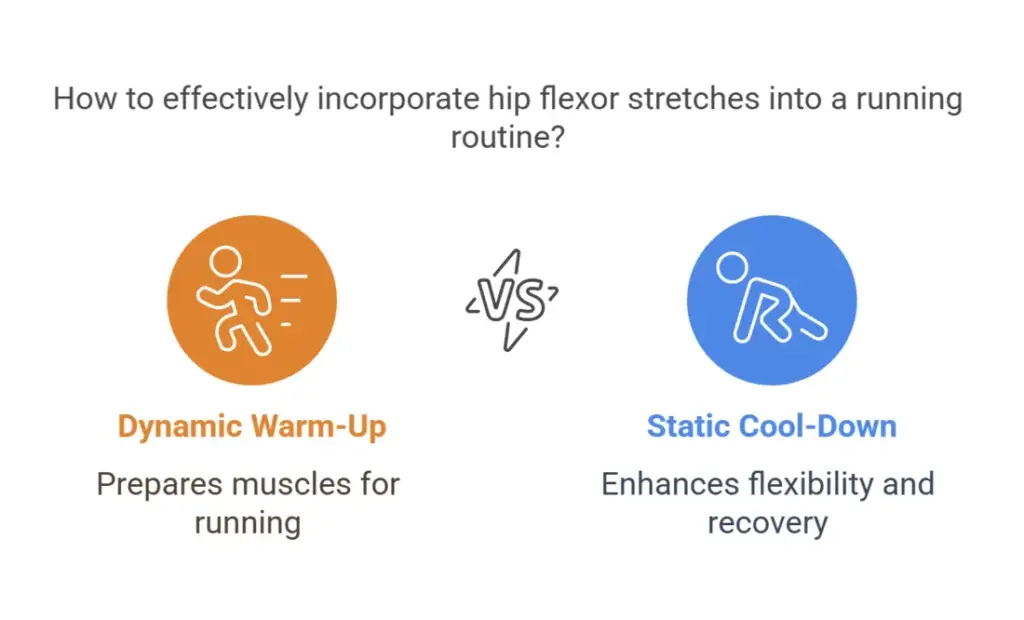
Knowing the right stretches is only half the battle—timing and consistency are equally important.
Here’s how to incorporate hip flexor stretches into your running regimen:
Hip Flexor Stretches Before Running – Dynamic Warm-Up
Before hitting the road or trail, focus on dynamic movements that gently warm up the hip flexors without overstretching cold muscles.
Dynamic stretches increase blood flow, improve mobility, and prepare your body for the demands of running.
Try these for 10-15 repetitions each:
- Leg Swings (Forward and Backward): Stand tall, holding onto a wall or stable object for balance. Swing one leg forward and backward, gradually increasing the range of motion. Keep your core engaged and avoid arching your back. This improves hip joint mobility and prepares the muscles for a wider range of motion during your run.
- Hip Circles: Stand on one leg and draw circles with your opposite knee in both clockwise and counterclockwise directions. Focus on controlled movements and engaging your hip muscles. This exercise loosens the hip joint and increases circulation to the surrounding tissues.
- High Knees: March or jog in place, bringing your knees up toward your chest. Emphasize proper form and a brisk pace. This dynamic movement activates the hip flexors and warms them up for the running motion.
- Walking Lunges: Take a large step forward and lower your body until both knees are bent at 90-degree angles. Alternate legs, maintaining an upright torso. This functional exercise improves hip mobility and strengthens the glutes and quadriceps.
Remember: The goal is to gently prepare your hip flexors for activity, not to push them to their maximum stretch before they’re warmed up.
Hip Flexor Stretches After Running – Static Cool-Down
After your run, when your muscles are warm and more pliable, it’s the perfect time to perform static stretches to improve flexibility and reduce muscle tension.
These stretches help restore the resting length of the hip flexors and promote recovery.
Hold each stretch for 30 seconds, focusing on deep breathing and gradual relaxation into the stretch.
- Kneeling Hip Flexor Stretch: Start in a half-kneeling position with your right knee on the ground and left foot planted in front. Gently push your hips forward until you feel a stretch in the front of your right hip. Hold, then switch sides. This classic stretch effectively targets the iliopsoas muscle.
- Standing Hip Flexor Stretch: Stand tall with feet hip-width apart. Take a step back with your right foot, keeping your heel raised. Bend your left knee slightly while keeping your right leg straight. Push your right hip forward while maintaining an upright torso. Hold, then switch sides. This is a convenient stretch for releasing tension after a run, especially if you’re short on time.
- Supine Hip Flexor Stretch: Lie on your back near the edge of a bed or bench. Bring both knees toward your chest. Hold your right knee close while allowing your left leg to hang off the edge. Gently lower your left leg, feeling the stretch in the front of your hip. Hold, then switch sides. This gentle stretch is perfect for those with sensitive lower backs.
- Prone Hip Flexor Stretch: Lie face down on a mat. Bend your right knee to a 90-degree angle. Grab your right ankle with your right hand. Gently pull your heel toward your glute. Hold, then switch sides. This more advanced stretch increases flexibility and engages your core.
Daily Maintenance
For runners with particularly tight hip flexors or those who sit for extended periods, daily stretching—even on non-running days—can be beneficial.
Consider these strategies:
- Set a reminder to stand up and perform a quick standing hip flexor stretch every hour during work
- Do a full hip flexor stretching routine before bed to counter the effects of sitting
- Use “movement snacks” throughout your day—short bursts of activity that engage the hips
Runner’s Story: As a software developer who runs marathons, I was the perfect storm for hip flexor issues—sitting all day, then demanding high performance from my body. I started using a timer app that reminds me to do hip flexor stretches hourly at my desk. In six weeks, my chronic IT band syndrome disappeared, and my running form feels more fluid than it has in years. — Carlos M., Boston Marathon qualifier
Additional Tips for Hip Flexor Health
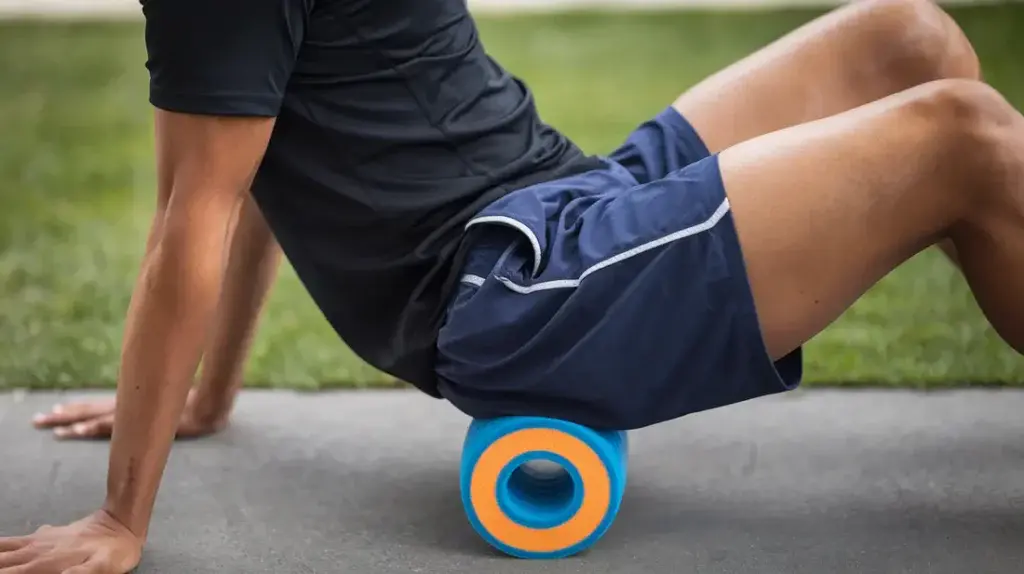
Foam Rolling Techniques
Foam rolling can help release tension in the hip flexors and surrounding muscles.
Here’s how to target this area:
- Lie face down with a foam roller positioned at the top of your thigh
- Support some of your weight on your forearms
- Slowly roll down the front of your thigh, pausing on tender spots for 20-30 seconds
- Breathe deeply and feel the muscle gradually release
Strengthening Exercises
Strong hip flexors are less prone to injury.
Incorporate these exercises into your routine 2-3 times per week:
- Straight leg raises: Lie on your back, keep one leg bent with foot flat on the floor, and lift the other leg straight up to 45 degrees
- Bridges: Lie on your back with knees bent, lift hips toward the ceiling by engaging glutes and core
- Mountain climbers: From a plank position, alternately drive knees toward chest in a controlled running motion
Proper Posture Practices
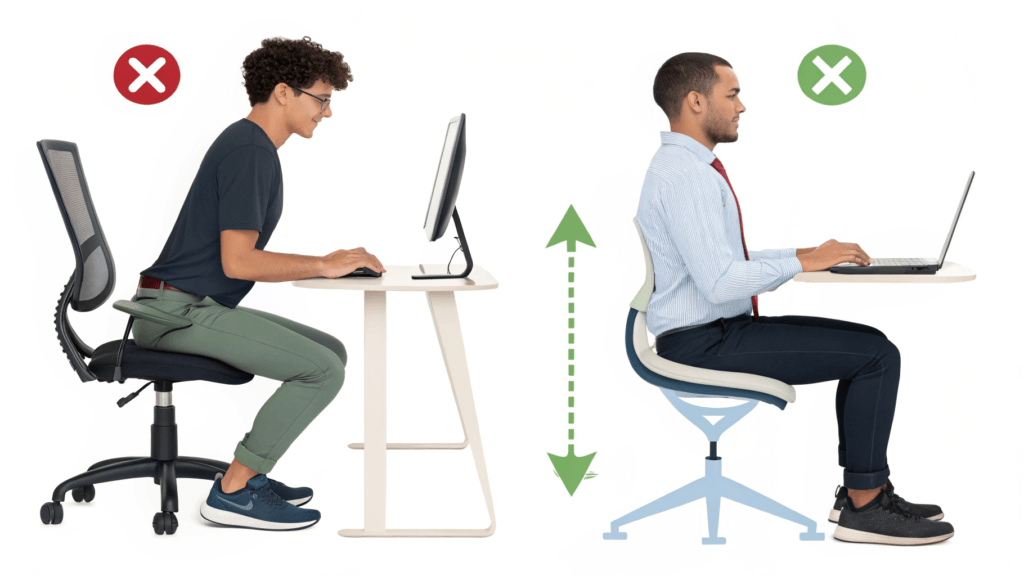
Many hip flexor issues stem from poor posture throughout the day:
- Sit with feet flat on the floor and knees at hip level or slightly lower
- Use a lumbar support or rolled towel to maintain the natural curve in your lower back
- Consider a standing desk or adjustable workstation to vary your position
- Set posture check reminders on your phone or computer
Regular Movement Breaks
Breaking up periods of sitting is crucial for hip flexor health:
- Stand up and move at least once every hour
- Take phone calls standing or walking
- Use a timer to remind yourself to change positions regularly
- Take the stairs instead of the elevator
- Park farther from destinations to incorporate more walking
Addressing Common Issues and Concerns
What to Do If You Experience Pain
While mild discomfort during stretching is normal, sharp pain is not:
- Stop any stretch that causes acute pain
- Distinguish between productive stretching sensations and potential injury
- Apply ice to inflamed areas for 15-20 minutes
- Consider consulting a physical therapist for persistent issues
- Don’t push through pain—modify stretches or seek professional guidance
How Long Does It Take to See Results?
Improvement timelines vary based on individual factors:
- Noticeable improvements in flexibility often occur within 2-3 weeks of consistent stretching
- Significant changes in running form and performance typically emerge after 4-6 weeks
- Some runners with severe restrictions may need several months of dedicated work
- Progress is rarely linear—be patient with plateaus and celebrate small victories
The key is consistency.
Five minutes of daily stretching will yield better results than an occasional 30-minute session.
Can Stretching Too Much Be Harmful?
Like most good things, stretching benefits come with caveats:
- Overstretching can lead to muscle instability or hypermobility
- Always warm up before deep stretching
- Listen to your body—stretching should never cause sharp pain
- Balance flexibility work with appropriate strength training
- Quality trumps quantity—proper technique is more important than duration
Frequently Asked Questions
Q: Can tight hip flexors cause lower back pain?
A: Yes, tight hip flexors can pull your pelvis into an anterior tilt, which increases the arch in your lower back and can lead to pain and discomfort, especially for runners.
Q: Should I stretch my hip flexors before or after running?
A: Both, but differently. Before running, focus on dynamic movements that warm up the hip flexors without overstretching cold muscles. After running, when muscles are warm, is the ideal time for deeper static stretches.
Q: How often should runners stretch their hip flexors?
A: Ideally, daily. Even on non-running days, maintaining hip flexor flexibility is important, especially if you spend much of your day sitting.
Q: Can hip flexor stretches improve my running speed?
A: Yes, improved hip flexor mobility can lead to a longer stride and better running economy, which can translate to faster running times.
Q: Are there any hip flexor stretches I should avoid?
A: Any stretch that causes sharp pain should be avoided. Also, aggressive stretches that push far beyond your current range of motion can be counterproductive or harmful.
Conclusion – Taking Strides Toward Better Running
Your hip flexors might be small in comparison to your quads or hamstrings, but their impact on your running efficiency, injury prevention, and overall performance is immense.
By incorporating these targeted stretches and supporting practices into your routine, you’re not just addressing a potential weak link—you’re optimizing your entire running system.
Remember that consistency is key.
Even five minutes of daily hip flexor care can yield significant improvements over time.
Be patient with your body, track your progress, and notice how small changes in flexibility translate to more comfortable runs, improved stride length, and a reduced risk of injuries.
Whether you’re training to improve your marathon time or simply want to enjoy pain-free neighborhood jogs, your hip flexors deserve attention.
Your future running self will thank you for the care you provide these crucial muscles today.
Want to learn more about optimizing your running form?
Check out our related article – Improve Your Running Form.
What hip flexor issues have you experienced in your running journey?
Have you tried any of these stretches with success? Share your experiences in the comments below!
References
- Saunders, P.U., Pyne, D.B., Telford, R.D. et al. Factors Affecting Running Economy in Trained Distance Runners. Sports Med 34, 465–485 (2004).
- Moffit TJ, Montgomery MM, Lockie RG, Pamukoff DN. Association Between Knee- and Hip-Extensor Strength and Running-Related Injury Biomechanics in Collegiate Distance Runners. J Athl Train. 2020 Dec 1;55(12):1262-1269. doi: 10.4085/1062-6050-0532.19. PMID: 33196827; PMCID: PMC7740053.
- Woods K, Bishop P, Jones E. Warm-up and stretching in the prevention of muscular injury. Sports Med. 2007;37(12):1089-99. doi: 10.2165/00007256-200737120-00006. PMID: 18027995.
- Faelli E, Panascì M, Ferrando V, Bisio A, Filipas L, Ruggeri P, Bove M. The Effect of Static and Dynamic Stretching during Warm-Up on Running Economy and Perception of Effort in Recreational Endurance Runners. Int J Environ Res Public Health. 2021 Aug 8;18(16):8386. doi: 10.3390/ijerph18168386. PMID: 34444136; PMCID: PMC8391672.
- Hall M, Chadwick Smith J. The Effects of an Acute Bout of Foam Rolling On Hip Range of Motion on Different Tissues. Int J Sports Phys Ther. 2018 Aug;13(4):652-660. PMID: 30140558; PMCID: PMC6088119.
- Miyachi R, Fujii Y, Nishimura T, Goda A, Nagamori Y, Kanazawa Y. Examining Movement Patterns, Skeletal Muscle Mass, and Hip Mobility in Office Workers With or Without Lower Back Pain: An Analytical Cross-Sectional Study. Cureus. 2024 Jul 17;16(7):e64721. doi: 10.7759/cureus.64721. PMID: 39156309; PMCID: PMC11328160.
Disclaimer: While we strive to provide accurate and helpful information, this article is for educational purposes only and should not replace professional medical advice. Always consult with a healthcare provider before beginning a new exercise regimen, especially if you have existing health conditions or injuries.


